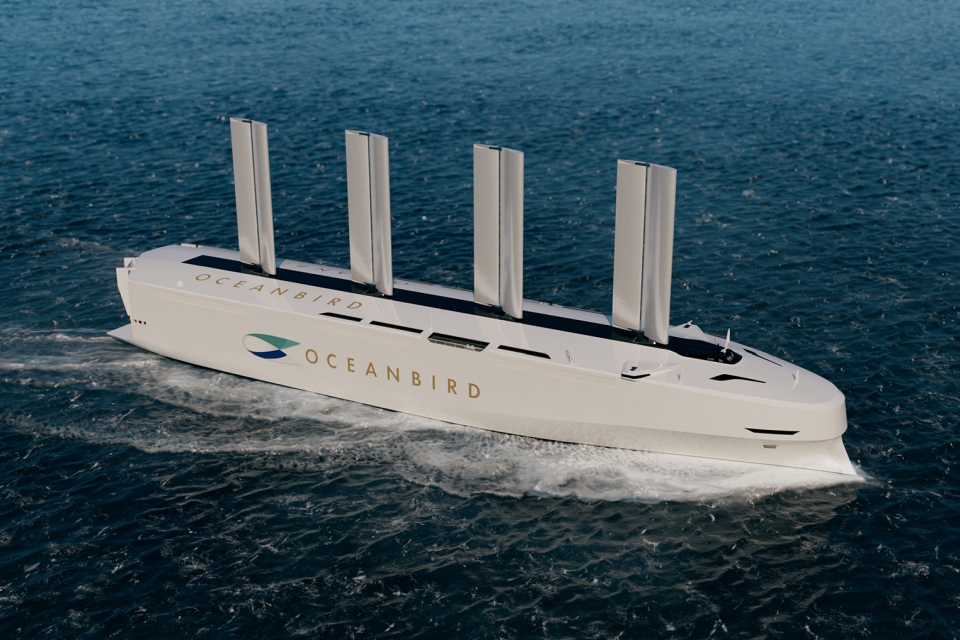In a next step towards realising the wind-powered vessel concept Oceanbird, a prototype of its Wing is currently undergoing tests in a wind tunnel. Later this year, there will be land-based testing of a full-scale version of the rig before retrofitting a vessel with one in 2024.
The Oceanbird is a RoRo sailing vessel concept said to reduce emissions by ninety per cent when compared to conventional vessels of the same type. The first vessel of this type to be built will be the Orcelle Wind.
Companies behind the project are Wallenius Wilhelmsen, Wallenius Marine, AlfaWall Oceanbird (a 50/50 joint venture of Alfa Laval and Wallenius), Volvo Cars, StormGeo, Maritime CleanTech, DNV, RISE Maritime (part of the Research Institutes of Sweden), KTH Royal Institute of Technology, Ghent University, NTUA (engineering university in Athens).
Opportunity of a lifetime
In a webinar at the end of January, the motivation for the Oceanbird project, its progress and upcoming steps were discussed.
‘There is no uncertainty about whether there is going to be decarbonisation. It is how, when, those kinds of questions,’ says Roger Strevens, VP Global Sustainability at Wallenius Wilhelmsen in the webinar when asked why they are working on the Oceanbird concept. ‘In short, the carbon will go, but shipping will remain. What that means to us, is that this is gigantic opportunity as well. It is the opportunity of a lifetime. And it is clear to us that we are going to need innovation with a capital I, now is the time for new ideas.’
In short, the schedule is as follows. Right now, a small prototype of the Wing and its control system are being tested in KTH’s wind tunnel. Next step is testing a full-scale land-based prototype, to take place this year. Next year, a vessel will be retrofitted with a full-scale wing for testing in a real-life environment.
Wing sail testing in wind tunnel
While sailors constantly need to adjust the sail, the Oceanbird Wings will automatically trim themselves in an optimal position. To achieve that, a reliable wing sail control system is needed and therefore Oceanbird and KTH Royal Institute of Technology are performing extensive tests in the KTH L2000 wind tunnel.
While the previous wind tunnel test has focused on the interaction between the wing sails, this test series is about finding the best way of trimming it in all possible configurations and the aerodynamics around stall hysteresis. It is the first wind tunnel test with the new two-segment wing design which optimises the performance by creating camber.
The prototype in the wind tunnel is fitted with neon threads. ‘When the threads are moving around, it means that the flow is not attached,’ explains Antonia Hillenbrand, Development Engineer at Oceanbird. ‘To get the largest lift force from the wind, we need to trim the wings in relation to the incoming flow so that they are as close as possible to the edge of where the flow is no longer attached and it stalls, but not crossing over it.’
The phenomenon called stall hysteresis has the effect that once the angle of attack is too large for the flow to be attached, the generated force is decreased drastically and the wing needs to be rotated back a lot more for building up a larger force again.
Sensitive aerodynamics
‘From my point of view, the most important will be tests for the control algorithm development,’ says Ulysse Dhomé, PhD student at the Centre for Naval Architecture at KTH. ‘We need to understand the physics behind what’s happening on these wings a bit better, so we can control them in the best possible way.’
Hillenbrand: ‘The new wind tunnel tests have already contributed to the knowledge of what the flow on our wing looks like especially around stall. We also learnt how sensitive aerodynamics are to small changes in the environment, especially on the small scale of the wind tunnel model. But also in full scale, changes in temperature and humidity will affect the aerodynamics, which can of course mean a lot for a long route around the world.’
‘Crazy physics’ in the wind tunnel
After some adjustments to the 1-metre-high model of the wing sail, Hillenbrand and Dhomé are going back into the tunnel in March 2023. The second test period is for validating the test setup and reducing uncertainties in the data. For this test round, the colourful threads have been removed.
‘We got important knowledge from the threads, they are a very good visualisation for example of where the flow detached first on the wing. The air flow is super sensitive to tiny changes, so foreseeing the disturbance of the tufts, we removed them for the next tests. It is some crazy flow physics happening around the wing, the next tests will be very interesting,’ says Hillenbrand.
Funding gets Oceanbird closer to reality
The Oceanbird project secured EUR 9 million from Horizon Europe recently for development and construction of the newbuild wind-powered vessel from the Oceanbird concept, which will be the Orcelle Wind. One of the deliverables along the way and already in 2024 is a full-scale Oceanbird test rig installation on an existing Wallenius Wilhelmsen vessel, called the Tirana.
Strevens: ‘The purpose of the Horizon funding programme is to create a framework for the different stakeholders to work together and take us from a concept to a real operating system. Nothing on this scale has been undertaken before. And when you have this kind of innovation with a capital I, you will also need funding with a capital F. And the Horizon funding will help us deliver on this exciting potential.’
Niclas Dahl, Managing Director Oceanbird, adds: ‘We have been working on this for a year now. This funding gives us the opportunity to build something full-scale and in real life. It also means we can do this stepwise. First, we will now build a full-scale land-based installation. This will allow us to work on optimisation of the assmebly part, look into how the mechanics are working, work on automation.’
‘As a second step, we put it on the vessel in order to really test it in real-life conditions and work on further optimisation,’ continues Dahl.

Towards full-scale
Dahl: ‘This is a test installation, so we are learning things all the time, but it does not mean we come from zero. We have doen a lot of tests in the past, have done smaller-scale prototypes, wind tunnel tests, CFD (computational fluid dynamics, ed.) calculations, so we have already come very far. Now it’s time to take the next step, to full-scale.’
As to where they are now, Dahl says: ‘We have set the design, we are as we speak ordering parts. During 2023 we will do a full-scale installation on land. In 2024, we will do the installation on the Tirana when it is in dry dock according to its normal dry docking schedule.’
Retrofit requires lot of work on vessel
According to Strevens they have found a vessel suitable to be retrofitted with an Oceanbird Wing in the Tirana. However, he stresses that ‘a lot of work has to go into preparing a vessel to carry a windsail, which has a significant weight and generates a lot of thrust. It is a vessel that wasn’t originally designed for this, so there are structural issues, stability issues, that need to be assessed. We have already come far in this work. But among the activities that we are still going to be kicking off are crew training.’
‘The land-based prototype will also be used for crew training, to build up the confidence and the feeling of understanding the product before you put it on board the ship,’ adds Dahl.
According to Emil Kotz, Technical Project Manager at Oceanbird, the biggest challenge of the retrofit for the Tirana is structural integration. He says: ‘Structural modifications to the hull are needed to meet the propulsive forces from the wingsail and finding the best solution in terms of minimum added weight.’
The main two materials used for the wing are high-strength steel used for the mast, the foundation and the tilting base, the other material is glass fibre sandwich with a recyclable core.
Cautious, but progressive
When it comes to the risks of taking on such a large project as Oceanbird, Dahl says: ‘It is a conservative market in general. It is always easier to understand what you have done before and take less risk in that way. But in order to comply in the future, you need to do something. There is a need to change and we will be needing new technology for that. We have everything in place now, we have the funding, the R&D, the partnership. So this is really a great start in moving towards sustainable shipping.’
Strevens adds: ‘We can’t be conservative anymore, but must be cautious. So we need a cautious, but progressive approach.’
Pictures and videos by Oceanbird.








